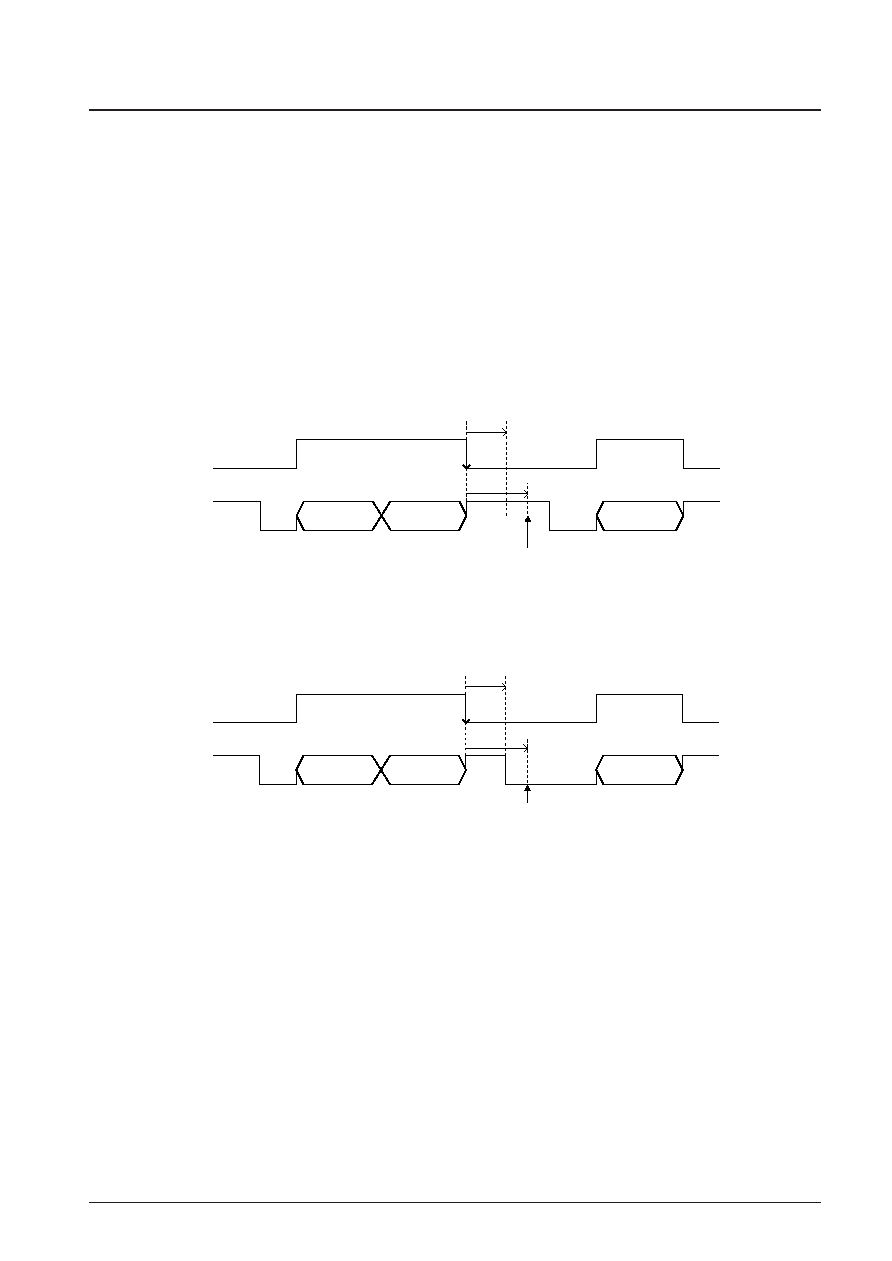- 您現(xiàn)在的位置:買賣IC網(wǎng) > PDF目錄30731 > LC72722PM SPECIALTY CONSUMER CIRCUIT, PDSO24 PDF資料下載
參數(shù)資料
| 型號(hào): | LC72722PM |
| 元件分類: | 消費(fèi)家電 |
| 英文描述: | SPECIALTY CONSUMER CIRCUIT, PDSO24 |
| 封裝: | MFP-24 |
| 文件頁(yè)數(shù): | 6/15頁(yè) |
| 文件大小: | 114K |
| 代理商: | LC72722PM |
第1頁(yè)第2頁(yè)第3頁(yè)第4頁(yè)第5頁(yè)當(dāng)前第6頁(yè)第7頁(yè)第8頁(yè)第9頁(yè)第10頁(yè)第11頁(yè)第12頁(yè)第13頁(yè)第14頁(yè)第15頁(yè)

No. 5602-14/15
LC72722, 72722M, 72722PM
CE pin
DO pin
(Last data)-1
Last data
New data
T
Tdo
DO check (Tdo < T)
A12386
2. When DO goes low 265 s after data is read out
Here, there is data that has not been read out remaining in the data buffer. In this case, applications are guaranteed to
be able to read out that data without it being overwritten by new data if they start a readout operation within 20 ms of
DO going low. (Note that this is the worst case condition.)
Notes: 1. Although an application can determine whether or not there is data remaining in the buffer by checking the DO
level with the above timing, checking the RE and RF flags in the serial data is a preferable method.
2. Applications are not limited to reading out one block of data at a time, but rather can read out multiple blocks
of data continuously as described above. When using this method, if an application references the RE and RF
flags in the data while reading out data, it can determine the amount of data remaining. However, the length of
the period for data readout (the period the CE pin remains high) must be kept under 20 ms.
3. If the DO pin is shared with other ICs that use the CCB interface, the application must identify which IC
issued the readout request. One method is to read out data from the LC72722 and either check whether
meaningful data has been read (if the LC72722 is not requesting a read, data consisting of all zeros will be read
out) or check whether the DO level goes low within the 256 s following the completion of the read (if the DO
pin goes low, then the request was from another IC).
CE pin
DO pin
(Last data)-2
(Last data)-1
Last data
T
Tdo
DO check (Tdo < T)
A12387
1. When the DO pin is high following the 265 s period (Tdo) after data is read out
Here, the buffer is in the empty state, i.e. the state where new data has not been written. After this, when the DO pin
goes low, applications are guaranteed to be able to read out that data without it being overwritten by new data if they
start a readout operation within 480 ms of DO going low.
DO pin operation
This IC incorporates a RAM data buffer that can hold up to 24 blocks of data. At the point where one block of data is
written to this RAM, the IC issues a read request by switching the DO pin from high to low when SP = 00. (See the CCB
input data fromat.)
The DO pin always goes high for a fixed period (Tdo = 265 s) after a readout and CE goes low. When all the data in the
data buffer has been read out, the DO pin is held in the high state until a new block of data has been written to the RAM.
(When SP = 00) If there is data that has not yet been read remaining in the data buffer, the DO pin goes low after the Tdo
time has elapsed.
After a synchronization reset, the DO pin is held high until synchronization is established. It goes low at the point where
the IC synchronizes(When SP = 00).
相關(guān)PDF資料 |
PDF描述 |
|---|---|
| LC72723M | SPECIALTY CONSUMER CIRCUIT, PDSO16 |
| LC72723 | SPECIALTY CONSUMER CIRCUIT, PDIP16 |
| LC72723M | SPECIALTY CONSUMER CIRCUIT, PDSO16 |
| LC72723 | SPECIALTY CONSUMER CIRCUIT, PDIP16 |
| LC72F3661 | SPECIALTY CONSUMER CIRCUIT, PQFP80 |
相關(guān)代理商/技術(shù)參數(shù) |
參數(shù)描述 |
|---|---|
| LC72722PM_12 | 制造商:SANYO 制造商全稱:Sanyo Semicon Device 功能描述:Single-Chip RDS Signal-Processing System IC |
| LC72722PM-MPB-E | 功能描述:音頻 DSP RoHS:否 制造商:Texas Instruments 工作電源電壓: 電源電流: 工作溫度范圍: 安裝風(fēng)格: 封裝 / 箱體: 封裝:Tube |
| LC72722PMS | 制造商:SANYO 制造商全稱:Sanyo Semicon Device 功能描述:Single-Chip RDS Signal-Processing System IC |
| LC72722PMS-MPB-E | 制造商:ON Semiconductor 功能描述:RDS/RBDS DECODE-IC - Ammo Pack |
| LC72722PMS-TLM-E | 制造商:ON Semiconductor 功能描述:RDS/RBDS DECODE-IC - Tape and Reel |
發(fā)布緊急采購(gòu),3分鐘左右您將得到回復(fù)。